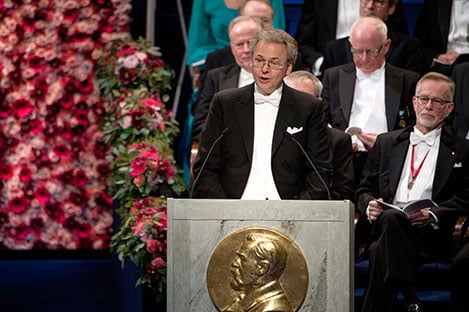Award ceremony speech
English
Swedish
Presentation Speech by Professor Olof Ramström, Member of the Royal Swedish Academy of Sciences; Member of the Nobel Committee for Chemistry, 10 December 2016.

Professor Olof Ramström delivering the presentation speech for the 2016 Nobel Prize in Chemistry at the Stockholm Concert Hall.
Copyright © Nobel Media AB 2016
Photo: Pi Frisk
Machines are an integral part of human development, helping us to perform tasks that often fall beyond our capacities. Over the millennia, our society has enjoyed an ever increasing plethora of useful machines for various purposes, in many ways leading to an enhanced quality of our lives. This progress has, in particular, accelerated since the industrial revolution, with its key discoveries resulting in a giant leap forward and dramatically changing the world.
Today, we are at the dawn of a new revolution that will bring us yet another giant leap forward. Humankind has always striven to push the limits of machine function and construction, for example regarding how small they can be made. The ultimate limit of this endeavour is to make molecular-sized machines, structures that are less than a thousandth of the width of a human hair. This fundamental challenge has been met by this year’s Laureates, who have successfully demonstrated that the rational design and synthesis of molecular machines are indeed possible.
A groundbreaking step in this development was taken in the early 1980s, when Jean-Pierre Sauvage and his group discovered an efficient way to make molecules that are attached to each other using mechanical bonds. The group thus managed to link two molecular rings together in a so-called catenane, where the rings could move freely relative each without being separated. This marked a breakthrough towards molecular machinery, and Sauvage was able to show how such structures can undergo controlled motion.
By the turn of the 1990s, Fraser Stoddart and his group made other important advances towards molecular machinery. For example, the group used another type of mechanical bond and developed so-called rotaxanes in which a ring-shaped molecule was tied to move between set positions along an axle. Both Stoddart and Sauvage were also able to show how the movement in these structures could be controlled from external input, and subsequently developed a wide range of machine-like structures, such as molecular muscles, actuators, elevators, memories, motors and pumps.
The motor components are of central importance in machines, able to drive other parts of the constructions. By the late 1990s, Ben Feringa and his group made a significant breakthrough when they demonstrated a molecular rotary motor. The construction was driven by light and heat and was based on isomerisable bonds and molecular asymmetry, where the motor parts could rotate unidirectionally relative each other. The group was later able to improve the design to create motors that can rotate in either direction at very high speeds, and showed how the components can affect the rotation of much larger objects. In a more playful example,
Feringa’s group also constructed a four-wheel drive “nanocar” that can move over a surface.
Through the design and synthesis of very challenging structures, combined with the understanding and development of controlled motion and function, Sauvage, Stoddart and Feringa have created functional molecular machines. Their work has formed the basis for an entirely new field of research, for which the three Laureates have been groundbreaking pioneers and sources of inspiration.
Jean-Pierre Sauvage, Sir Fraser Stoddart, and Ben Feringa:
You are being awarded the Nobel Prize in Chemistry for the design and synthesis of molecular machines. On behalf of the Royal Swedish Academy of Sciences I wish to convey to you our warmest congratulations. May I now ask you to step forward and receive your Nobel Prizes from the hands of His Majesty the King.
Nobel Prizes and laureates
Six prizes were awarded for achievements that have conferred the greatest benefit to humankind. The 14 laureates' work and discoveries range from quantum tunnelling to promoting democratic rights.
See them all presented here.
